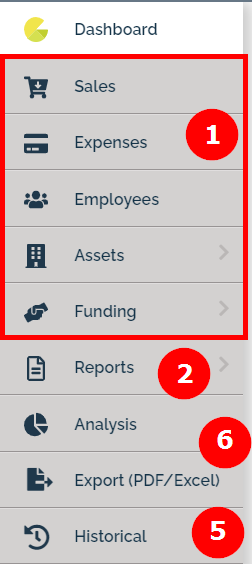
Glad to see you here!
Ready to start exploring the app?
Before you read further, check out our Welcome to Budgeto | DEMO video (15 min), which explains what Budgeto is all about.
Become a Budgeto expert by watching the other training videos available! These training videos can be found in our Multimedia Gallery (Be sure to check back often, as more training videos are in the works!).
Click here to access the Budgeto Multimedia Gallery
Have you opened your Account yet?
Click here to begin creating your Budgeto account! Or click on the "Sign up here" button on the login page. |
How to navigate within the Budgeto app
There are 3 menus within the Budgeto app:
- Company menu;
- Top menu;
- Left side menu.

Company Menu (1)
The COMPANY MENU is the first dark gray bar located at the top of the app. Use this menu to select which company you are working in (arrow next to the company name), access your company and user settings, contact us and support, and search for articles within our Knowledge Base.
Top Menu (2)
The TOP MENU consists of all options in the second gray bar on the Budgeto website. What can you find/do in the TOP MENU: Budget Name (select a different budget, review list of budgets, etc.), add a budget, rename a budget, duplicate a budget, and share a budget.
Left Hand-Side Menu (3)
The LEFT HAND-SIDE MENU consists of all the forms you need to fill in order to build your budget/future financial projections, your historical data, as well as your reports. This menu contains the following sections that will need to be completed:
- SALES: Allows you to create goods or services and plan their schedule of sale.
- EXPENSES: Allows you to create expenses, to manage their occurrence, and to choose a payment term for your suppliers.
- EMPLOYEES: Allows you to hire employees, to identify their first month of work and to manage their salary on an annual or monthly basis.
- ASSETS: Allows you to enter your capital assets and investments.
- FUNDING: Allows you to enter your lines of credit, debts, share capital, grants, and tax credits.
- REPORTS: Allows you to view and print out various professional-looking financial projection reports such as profit and loss statement, balance sheet, ratios, etc.
- ANALYSIS: Allows you to analyze and compare the variances between different entities/scenarios and time frames.
- EXPORT: Export your reports in PDF or Excel.
- HISTORICAL: Review your historical data* (For existing businesses, not start-ups).
How to start from existing accounting data
Follow this link to access the Historical Dashboard within the Budgeto app.
How to build your budget
- Step 1: fill the forms (sales, expenses, employees, assets, funding);
- Step 2: see the impact live in your reports (reports menu);
- Step 3: share your business with your accountant, bank, investors, etc. (share menu);
- Step 4: create budget scenarios, like pessimistic and optimistic scenarios (duplicate menu);
- Step 5: if you are an Existing Business*, enter your past historical information (historical menus);
- Step 6: export your reports in PDF or Excel (export menu).


Need help? These resources are for you!

1- There is a search bar at the top right of the screen, use it often! Use words that you see on the section you are dealing with in order to search for related articles in our Knowledge Base.
2- If you haven't found an answer to your question, create a support ticket and our team will find an answer for you:
Click here to create a new ticket for help
3- If you have any other questions about Budgeto, write us an email at: support@budgeto.com
Happy Budgeting and know that we are here for you if you need help!
The Budgeto Team
Join the Conversation!
Follow us on our social media channels for Budgeto tips, how-to guides, company updates, and more!
Related Articles (Please refer to the links below)
- Budgeto Roadmap: Upcoming & Released Product Features
- How to import HISTORICAL DATA into Budgeto


